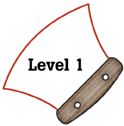
Alaska Science
Key Element A14a
A student who meets the content standard should understand the interdependence between living things and their environments (Interdependence).
 |
Alaska Science A student who meets the content standard should understand the interdependence between living things and their environments (Interdependence). |
|
Performance Standard Level 1, Ages 5–7
|
|
|
|
Sample Assessment Ideas
|
|
|
Expanded Sample Assessment Idea
|
|
Procedure Students will:
Reflection and Revision
|
Levels of Performance |
||
|
Stage 4 |
Student work is complete, correct, detailed, and shows evidence of logical reasoning. Student demonstrates ability to group all of the birds according to diet and describe birds and their foods in great detail. | ||
|
Stage 3
|
Student work is complete, although minor inaccuracies may be present. Student demonstrates ability to group most of the birds according to diet and describe birds and food lists in some detail. | ||
|
Stage 2
|
Student work may be incomplete, show evidence of misconceptions or contain errors of science fact and reasoning. Descriptions of birds and food list are limited and student has difficulty grouping birds. | ||
|
Stage 1
|
Student work is largely incomplete, incorrect, shows little evidence of understanding and may contain major misconceptions. | ||
Standards Cross-References
|
||
|
National Science Education Standards Organisms have basic needs. For example, animals need air, water, nutrients, and light. Organisms can survive only in environments in which their needs can be met. The world has many different environments, and distinct environments support the life of different types of organisms. (Page 129) All animals depend on plants. Some animals eat plants for food. Other animals eat animals that eat the plants. (Page 129) Resources are things that we get from the living and non-living environment to meet the needs and wants of a population. (Page 140) Some resources are basic materials, such as air, water, and soil: some are produced from basic resources, such as food, fuel, and building materials; and some resources are non-material, such as quiet places, beauty, security, and safety. (Page 140) The supply of many resources is limited. If used, resources can be extended through recycling and decreased use. (Page 140) |
Benchmarks Animals eat plants or other animals for food and may also use plants (or even other animals) for shelter and nesting. (Page 116) Living things are found almost everywhere in the world. There are somewhat different kinds in different places. (Page 116) |
|
Table of Contents | Return to Alaska Native Knowledge Network